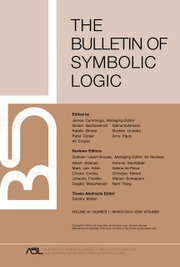No CrossRef data available.
Article contents
A ONE-PAGE PROOF OF A THEOREM OF BELEZNAY
Published online by Cambridge University Press: 18 March 2025
Abstract
We give a short proof of a theorem of Beleznay asserting that the set  $L2$ of reals coding linear orders of the form
$L2$ of reals coding linear orders of the form  $I + I$ is complete analytic.
$I + I$ is complete analytic.
MSC classification
- Type
- Article
- Information
- Copyright
- © The Author(s), 2025. Published by Cambridge University Press on behalf of The Association for Symbolic Logic
References
Becker, H.,
Descriptive set theoretic phenomena in analysis and topology
,
Set Theory of the Continuum
(Judah, H., Just, W., and Woodin, H., editors), Springer-Verlag, New York, 1992, pp. 1–25.Google Scholar
Beleznay, F.,
The complexity of the collection of countable linear orders of the form
 $I+I$
.
Journal of Symbolic Logic
, vol. 64 (1999), pp. 1519–1526.CrossRefGoogle Scholar
$I+I$
.
Journal of Symbolic Logic
, vol. 64 (1999), pp. 1519–1526.CrossRefGoogle Scholar
Harrison, J.,
Recursive pseudo-well-orderings
.
Transactions of the American Mathematical Society
, vol. 131 (1968), pp. 526–543.CrossRefGoogle Scholar
Humke, P. D. and Laczkovich, M.,
The Borel structure of iterates of continuous functions
.
Proceedings of the Edinburgh Mathematical Society
, vol. 32 (1989), pp. 483–494.CrossRefGoogle Scholar
Marcone, A. and Montalbán, A.,
The Veblen function for computability theorists
.
Journal of Symbolic Logic
, 76 (2011), pp. 575–602.CrossRefGoogle Scholar



